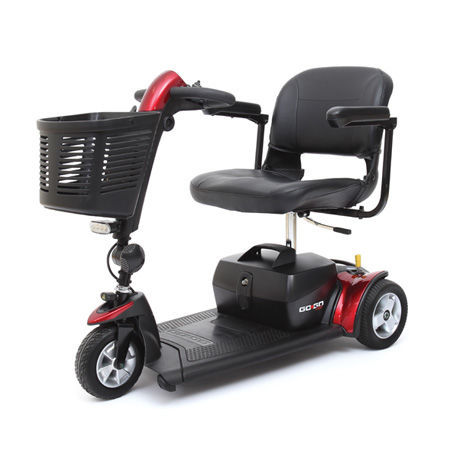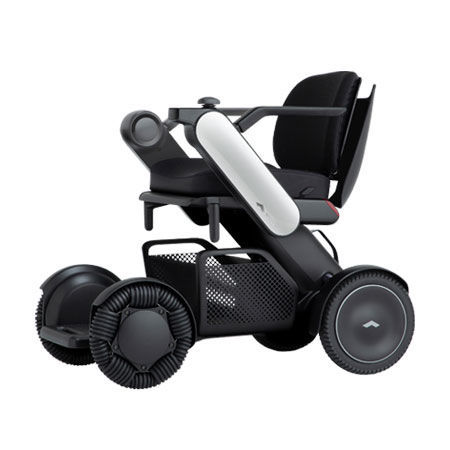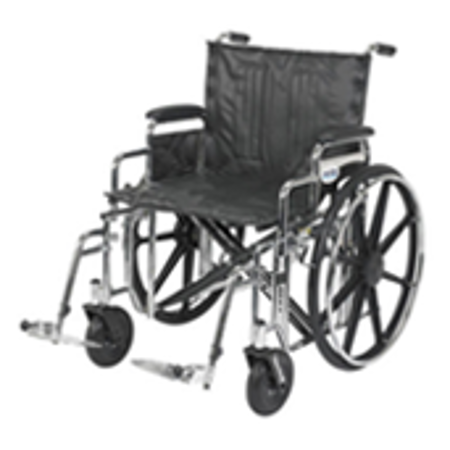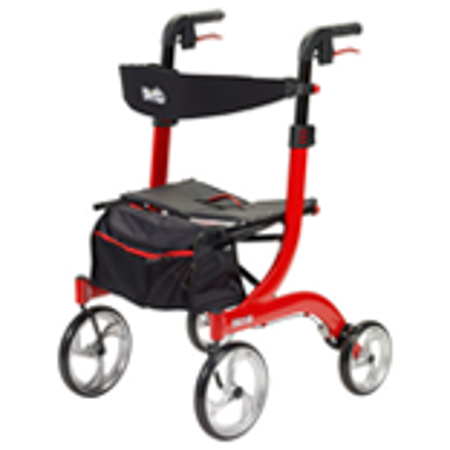Manual Wheelchairs are a solid all-around option for people with mobility issues, as they are transportable, foldable, and easy to use. Manual wheelchairs are designed to be durable and comfortable, and while they are often thought of as a temporary mobility solution, many people use wheelchairs as their primary means of personal transportation.
This wheelchair buying guide offers insight into the wheelchair buying process, from answering a few frequently asked questions to highlighting the most popular manual wheelchairs, the best options for seniors, and how to decide if a manual wheelchair is right for you.
- What is the difference between a wheelchair and a transport chair?
- Do I need a wheelchair?
- Do I qualify for a wheelchair?
- Do I need a prescription for a wheelchair?
- Can you get a wheelchair for free?
- How long do wheelchairs last?
- How long do wheelchair batteries last?
- How much does it cost to buy a wheelchair?
- How long does it take to get a wheelchair?
- How do I go about getting a wheelchair?
- How do I choose a wheelchair size?
- What are the best wheelchairs?
- What are the easiest wheelchairs to push?
- What is the best wheelchair for seniors?
- What is the best lightweight wheelchair?
- Features you need (or should look for) when buying a wheelchair?
- Conclusion.

Wheelchair Buying FAQ
What is the difference between a wheelchair and a transport chair?
Transport wheelchair:
Transport wheelchairs are narrow, smaller-wheeled chairs that are designed to be pushed by a caregiver. A transport chair is light, compact, and easy to navigate, which makes it an excellent option for travel and use outside of the home, or as a companion to a larger manual or electric wheelchair.
Transport wheelchairs are different from standard wheelchairs in that the wheels are smaller and the body is more narrow to make them easier to push and maneuver. Transport chairs cannot be manually propelled, which means that the wheelchair user cannot operate this chair unassisted. For more information on Transport Wheelchairs, visit our Transport Wheelchair Buyers Guide.
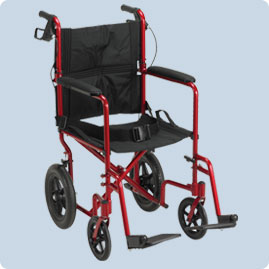
Transport Wheelchair
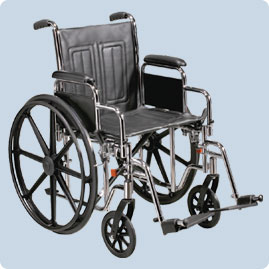
Standard Wheelchair
Standard wheelchair
A standard wheelchair (or manual wheelchair) is a mobility chair with large rear wheels and smaller front wheels that are designed to be pushed by a caregiver or manually propelled by the wheelchair user. This design allows the user to reach the rear wheels and push themselves while seated. Standard wheelchairs are collapsible, transportable, and easy to use by both a wheelchair user or a caregiver.
Do I need a wheelchair?
If you are unable to walk unassisted and can only take a few steps before needing to rest, you may benefit from a wheelchair. You may also need a wheelchair if you find it difficult to walk long distances even with assistance (i.e. from a friend or family member, or another assistive device like a cane).
If you struggle to walk on your own and feel you may benefit from a wheelchair, you should first discuss your mobility limitations with your doctor. At the appointment, your doctor will evaluate your needs and may prescribe you with a wheelchair.
Do I qualify for a wheelchair?
“Qualifying for a wheelchair” is a phrase used to describe your necessity for a wheelchair, decided by your doctor, and if you fulfill the requirements put in place by your insurance provider to cover the costs of your wheelchair.
To qualify for a wheelchair, you need to demonstrate to your doctor that you have limited mobility and are physically capable of operating a wheelchair unassisted. If your limited mobility interferes with daily tasks – from getting around your house to completing essential functions such as getting dressed – you may qualify for a wheelchair.
To operate a wheelchair, you will need to be able to sit and support yourself unassisted, physically operate the controls and navigate appropriately, and be able to get in and out of the wheelchair on your own.
Your doctor can determine your medical necessity for a wheelchair by evaluating your mobility limitations, as well as discussing how you feel you’d benefit from a wheelchair. During your assessment, your doctor will determine if your daily limitations meet the requirements for needing a wheelchair.

Do I need a prescription for a wheelchair?
You do not need a prescription to buy or use a wheelchair. The reason you would need a prescription for a wheelchair is if you’re looking to use an insurance benefit to cover the costs of your wheelchair.
If a doctor has determined your need for a wheelchair, you may then qualify for insurance coverage to help with the wheelchair costs. A doctor’s prescription will be required to receive insurance coverage.
Can you get a wheelchair for free?
Your insurance can completely cover the expenses associated with a wheelchair depending on your medical necessity, your prescription, and your insurance coverage.
To get a wheelchair for free, you will need a prescription to verify your medical necessity. If you have a prescription, you can then work with your insurance provider and a mobility equipment provider to find the appropriate wheelchair that is fully covered by your insurance plan.
Your plan may cover the initial cost of your wheelchair, but this may not include lifetime expenses such as maintenance, upgrades, and additional mobility devices.
How long do wheelchairs last?
The average lifespan of a wheelchair is 2 to 3 years, with a maximum of 5 years for manual wheelchairs. The more a wheelchair is used, the shorter the lifespan will be due to daily wear and tear.
You may find that your mobility needs change within this time frame, or you may want to upgrade your mobility device before your wheelchair wears out.
Before purchasing a wheelchair, you should consider how frequently you’ll be using the chair. Are you only going to be using the wheelchair occasionally? Or will it be your primary, everyday mobility device? This will help you choose the right wheelchair for your needs and will allow you to get the most out of your chair throughout its lifespan.
How long do wheelchair batteries last?
A brand new, fully charged power wheelchair battery can last upwards of 8 hours on a single charge and cover around 10 to 20 miles of distance. Overall battery health declines as the battery is used, both in the length of time it will last and the range it covers.
Power wheelchair batteries should be replaced every one and a half to two years to ensure you have the proper power for your daily use. Depending on your usage, a power wheelchair battery can last from 6 months to 2 years before requiring a replacement.
For more information on power wheelchair batteries, please see our blog post on how long a wheelchair battery lasts.
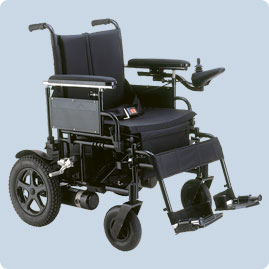
Power Wheelchair
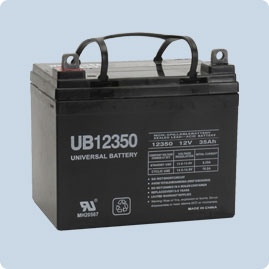
Power Wheelchair Battery
How much does it cost to buy a wheelchair?
Wheelchairs have several costs to consider, including the upfront cost to buy the equipment, as well as the costs for maintenance, upkeep, accessories, and modifications.
The base price of a wheelchair depends on the make, model, and style, with manual wheelchairs costing less on average than power wheelchairs. Heavy duty wheelchairs also have a slightly higher average price point.
The average manual wheelchair available on scootaroundstore.ca costs approximately $425.00, with the least expensive options costing $200.00 or less.
Wheelchairs can be purchased or rented depending on your needs and the availability of specific models. It can often be more cost effective to rent a wheelchair near you to get a feel for the style, model, and functionality before making a large purchase.
For more information about renting and buying wheelchairs, visit our Mobility Rentals page and our Online Store.

How long does it take to get a wheelchair?
The process from qualifying for a wheelchair to completing your purchase and having a wheelchair at your disposal can take weeks or months, as qualification starts with a doctor’s appointment and a discussion.
The actual purchasing of a wheelchair typically takes a few weeks, as it’s a good idea to test out a few wheelchairs in person at a retail store or rental location to ensure your choice suits your needs. Wheelchairs can be purchased at your local medical supplier or through online retail websites.
It can take anywhere from a few days to a few weeks to get a wheelchair, depending on what you’re looking for and what’s available. Both local suppliers and retail websites will help guide you through the purchasing process to ensure the wheelchair you select suits your needs and fits your lifestyle.
When purchasing a wheelchair through Scootaround Powered by WHILL, most wheelchairs are shipped between 5 and 7 business days after you complete your purchase.
How do I go about getting a wheelchair?
There are two main ways to go about getting a wheelchair. The first is by visiting your doctor to be evaluated for a wheelchair. This will verify that your mobility limitations require a wheelchair and your doctor may provide you with a prescription, which allows your insurance to cover some of the costs. You may also need a certificate of necessity to go this route. Once you have these two things, you will need to work with a local or online retail supplier to purchase the device.
The second way to get a wheelchair is to visit a local retail supplier or an online store, such as Scootaround. This will provide you with the biggest selection of wheelchairs and will let you shop at your own pace to find something that suits your needs.
If you decide to buy a wheelchair without a doctor’s guidance, you will most likely have to cover the full cost of the wheelchair, as insurance has specific requirements for covering these costs.
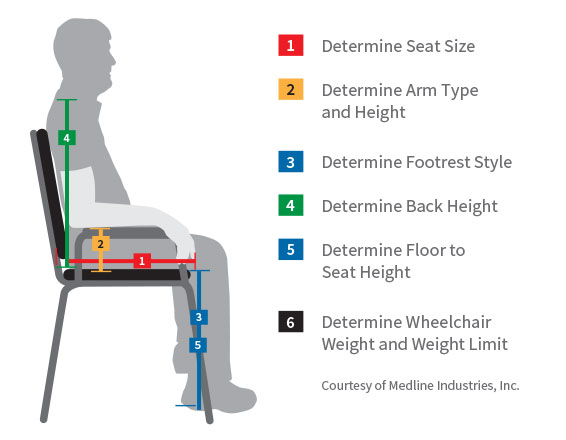
How do I choose a wheelchair size?
Choosing a proper size for your wheelchair depends greatly upon the width of the seat you will require. The seat of the wheelchair dictates the layout, wheel size, and other secondary features of the device. Seat widths typically range from 16 to 20 inches, with an average width of about 18 inches.
You should also take the seat depth into consideration, as this will make a difference in overall comfort and usage. Seat depth is the distance from the back of the seat to the front edge and should be measured when the user is sitting straight up. Seat size determines the wheelchair’s overall size, which can affect how easy it is to navigate doorways, hallways, and other tight spaces. Size also affects wheelchair turning radius, which determines how tightly the chair can make a 180-degree turn.
Compact wheelchairs have a narrower seat, making them easier to maneuver and transport than standard manual wheelchairs with wider seats. For more information on the best wheelchairs for tight spaces, check out our post on narrow wheelchairs. You can also get more info on the best narrow manual wheelchairs and powerchairs at our Best Compact Narrow Wheelchairs post.
What are the best wheelchairs?
The best wheelchair is the one that suits your needs, fits your budget, and integrates well into your daily life. With so many wheelchairs on the market, it can be intimidating to try and choose the right one, especially if you’ve never purchased a wheelchair before. The following are the top 6 most popular wheelchairs from Scootaround, which will give you a good idea of what wheelchair users prefer and some of the key specifications to look for:
1. | Drive Silver Sport II | |
2. | Blue Streak Wheelchair | View Price |
3. | Everest & Jennings Traveler Recliner Wheelchair | View Price |
4. | Drive Designer Flyweight Transport Chair | |
5. | Drive Cougar Folding Wheelchair | View Price |
6. | Acadia Standard Wheelchair | View Price |
1: Scootaround’s most popular manual wheelchair is the Drive Silver Sport II, a folding wheelchair from Drive Medical. This wheelchair comes in two seat widths (18 and 20 inches) and has a weight capacity of 250 lbs. This easy-folding wheelchair has a low body weight and comes with a vinyl seat. The Drive Silver Sport II is also easy to maintain and has a clean design. View Price
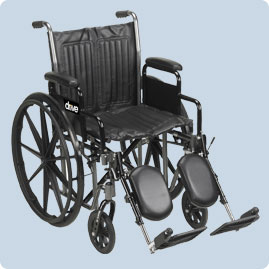
Drive Silver Sport II
2: Another tremendous manual chair option from Drive Medical is the Blue Streak Wheelchair with Flip Back Desk Arms. This wheelchair has a 16-inch seat width and is designed to fit under desks and tables. This is an excellent wheelchair for users who want convenience, comfort, and independence. View Price
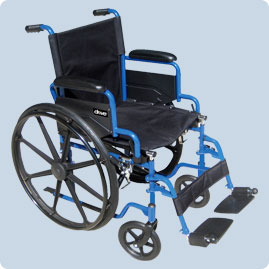
Blue Streak Wheelchair
3: The Everest & Jennings Traveler Recliner Wheelchair is a best-selling manual wheelchair. This make and model comes with a higher back for more support and is a solid option for those looking to purchase through insurance. The Traveler Recliner Wheelchair is sturdy, easy to fold, and is compatible with other E&J manual wheelchair parts. View Price
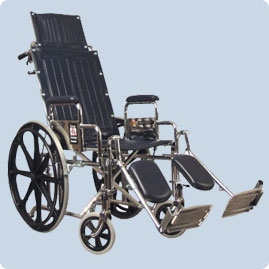
Everest & Jennings Traveler Reclining Wheelchair
4: The most popular transport chair in Scootaround’s online store is the Drive Medical Drive Designer Flyweight Aluminum Transport Chair. The lightweight frame makes this chair easy to travel with. This model also comes in two interesting upholstery colors (tan plaid and red plaid) for a custom look. View Price
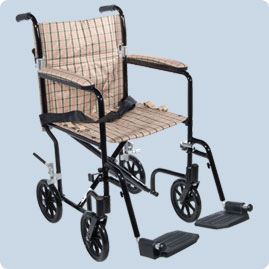
Drive Designer Flyweight Transport Chair
5: The Drive Cougar Folding Wheelchair is a great option for users who are looking to customize their wheelchair to their specific needs. Offered in three different seat widths, this lightweight chair features an aluminum frame, a folding back, and smooth roll wheels. The armrests and back can be adjusted without using extra tools, allowing you to easily tweak the wheelchair for the best possible experience. View Price
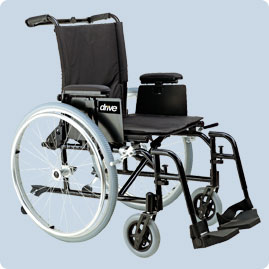
Drive Cougar Folding Wheelchair
6: With its mix of comfort, quality, and practicality, the Acadia Standard Wheelchair is another popular choice for wheelchair users. This chair has two seat width options (16 and 18 inches), providing a comfortable and spacious ride. Seat height can also be adjusted. The padded armrests add extra comfort, while the solid black body makes the Acadia Wheelchair a sleek, stylish option. View Price
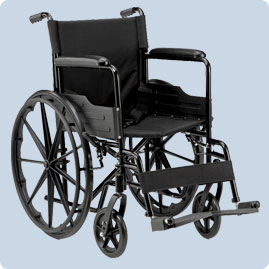
Acadia Standard Wheelchair
What are the easiest wheelchairs to push?
Because they are designed to support the user’s weight evenly, most wheelchairs are very easy to push. The two easiest wheelchair types to push are transport chairs and travel wheelchairs. These wheelchair styles are specifically designed to be pushed by a companion, and both rely on a lightweight frame, simple construction, and narrow seat to make them easier to maneuver while pushing.
All Scootaround wheelchair options are easy to push and transport.
What is the best wheelchair for seniors?
The best wheelchair for seniors is one that is lightweight, user-friendly, and easy to fold and transport. Wheelchairs that meet these requirements allow senior wheelchair users to maintain their independence and increase their mobility without requiring the assistance of others.
One of the best examples of a wheelchair for seniors is the Cruise III Light Weight Wheelchair by Drive Medical. This wheelchair has a carbon steel frame, which allows for custom seating to be installed, as well as add-on accessories. It provides a smooth ride and is easy to maintain and keep clean. The removable arms also make it easy to transfer in and out of.
For more information about how to shop for a wheelchair for seniors, check out our Best Wheelchairs for Elderly People Guide. Or, if you’re looking for advice on how to transport a potential new wheelchair, take a look at our blog post which provides tips for transporting your chair.
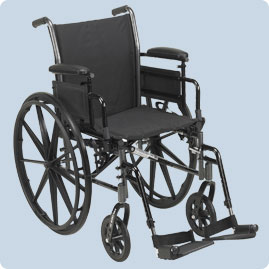
Cruiser III Lightweight Wheelchair
What is the best lightweight wheelchair?
Prospective wheelchair buyers are often interested in purchasing a lightweight wheelchair. As the name suggests, these wheelchairs have a light body and are very portable. This makes them a great primary chair option, as they can be easily transported from your home to either school or work. Lightweight wheelchairs also make excellent temporary or backup travel chairs since they can be easily folded and taken out to complete errands or see the sights.
The following are some of the lightest wheelchair options Scootaround currently has in our store. All of these chairs are 55 pounds or less and have many of the benefits wheelchair users look for in a lightweight chair.
1: Drive Cougar Folding Wheelchair
This ultralight manual folding wheelchair provides many great features in a small package. Weighing in at 27 pounds, this aluminum-framed chair can support up to 250 pounds. The forward folding back helps this wheelchair keep a small profile, and the spoke wheels provide a smooth and true roll. There’s also plenty of room for customization – the Drive Cougar Folding Wheelchair can be ordered in three different widths, while the adjustable armrests and back height make it easy to tailor the chair to your needs without the use of tools. Lastly, this chair folds to a width of 12 inches, which makes it a top wheelchair for travel and frequent use.

Drive Cougar Folding Wheelchair
2: Drive Silver Sport II
As mentioned above, the Silver Sport II by Drive Medical is a solid option for those looking to purchase a lightweight wheelchair. It is easily foldable, has a low body weight (less than 45 pounds), and has a slew of great customization options. The Drive Silver Sport II is available in 3 different seat widths, with the widest being 20 inches. The vinyl upholstery makes this chair easy to clean and maintain, and the silver powder coated frame gives the chair a classy look.

Drive Silver Sport II
3: Blue Streak Wheelchair
This lightweight wheelchair was explicitly designed with independence and comfort in mind. The overall weight is 41 pounds, which is quite light considering how many comfort features are built into this wheelchair. The frame and back brace make the seat robust, yet light, while the nylon upholstery is easy to clean and holds up well over time. The solid rubber tires give you a smooth, durable ride, and the padded armrests add even more comfort. This is a great all-around lightweight wheelchair with solid features from top to bottom.

Blue Streak Wheelchair
4: Acadia
If you need a simple, no frills lightweight wheelchair that is still very dependable, the Acadia is a solid choice. Coming in at 35 pounds, this wheelchair is available in two seat widths, 16 or 18 inches, and is designed for both comfort and function. The adjustable design allows users to customize their seating position for a more comfortable ride, and the padded fixed armrests elevate the user experience. Additionally, the solid black frame and upholstery make this a sleek-looking lightweight wheelchair option.

Acadia
5: Glacier
Like the Arcadia, the Glacier is another simple and solid choice for a lightweight wheelchair. Designed for average to above average body sizes, this wheelchair provides a comfortable ride without a ton of bells and whistles. The height adjustment offers a custom ride that is supportive and stable, while the lightweight aluminum frame reduces the body weight to only 31 pounds. Another nice feature are the removable desk height armrests, which make it easy to transfer in and out of the wheelchair.
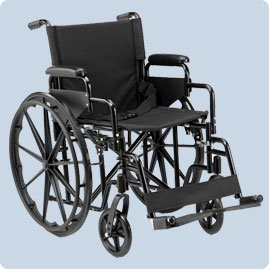
Glacier
6: Everest & Jennings Traverler Recliner Wheelchair
If you want a wheelchair that is durable and dependable, take a look at the Traveler Recliner Wheelchair from Everest & Jennings. Although it’s the heaviest wheelchair on our list at 55 pounds, this particular model is separated by its full reclining back, which provides additional support for the user. The chair also has detachable padded armrests and elevating leg rests for added comfort.

Everest & Jennings Traveler Recliner Wheelchair
7: Cruiser III
The Cruiser III Wheelchair is a lightweight option with some room for customization. The flip back, detachable arms and swing away footrests make it easy to get in and out of the chair, while the carbon steel frame lets you customize your back insert and leaves room for adding accessories. The Cruiser III also offers a smooth ride, and at 38 pounds with a 20-inch seat, it’s an excellent option for many wheelchair users.

Cruiser III
8: Wallaby Pediatric Folding Wheelchair
Active users will want a lightweight and transportable folding wheelchair, and the Wallaby Pediatric delivers just that. This wheelchair has padded flip-back desk arms, several safety straps, adjustable height push handles, and a narrow body with a seat width of just 12 inches. The body comes in either a bright red or bright blue frame, making this a fun option for kids who need a safe and comfortable lightweight wheelchair.
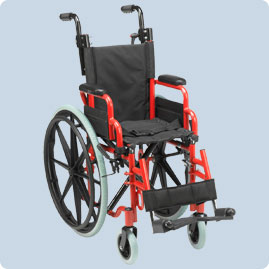
Wallaby Pediatric Folding Wheelchair
9: Yosemite Pediatric Wheelchair
With a total weight of only 33 pounds, the Yosemite Pediatric Wheelchair is another great lightweight option for younger wheelchair users. This chair has a slightly wider seat than the Wallaby at 14 inches, along with a higher weight capacity of 200 pounds. The Yosemite also has detachable desk heights arms, nylon upholstery, and solid rear tires.
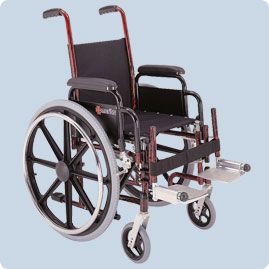
Yosemite Pediatric Wheelchair
10: Drive Designer Flyweight Transport Chair
Transport chairs also make great lightweight wheelchair options. The Designer Flyweight Transport Chair by Drive has an aluminum frame that reduces the body weight to 19 pounds. This chair is comfortable, easy to push, and the upholstery comes in two patterned fabrics for a stylish, custom ride.

Drive Designer Flyweight Transport Chair
11: Super Light Transport Chair
The last lightweight wheelchair option is this Super Light Transport Chair by Drive Medical. At 19 pounds, this is one of the lightest chairs available. It even comes with its own carry bag for transportation, so you can easily take the chair wherever you go. This wheelchair is easy to use and folds like a conventional chair, allowing it to be stored in a trunk or storage compartment. The padded arms provide additional comfort, while the maintenance-free wheels ensure you’re always getting a smooth ride.
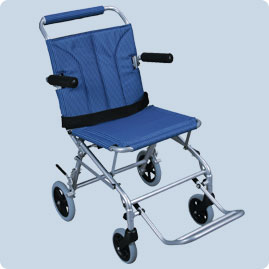
Super Light Transport Chair
Features you need (or should look for) when buying a wheelchair:
When shopping for a wheelchair, there are a number of major components you need to take into consideration. The following will give you a good idea of what’s available, what to look for, and what to consider before making your purchase.
Comfort
Any wheelchair that is being used on a daily basis needs to be comfortable. The seat is the most crucial element to consider here. Most are made of either nylon or vinyl, and some chairs may require a cushion or custom back support to increase comfort. Seat width and depth are also important considerations, as you’ll want a seat that fits the user perfectly.
Cushion
A cushion can be added to a wheelchair seat to increase comfort, support, and stability. Gel cushions can add extra comfort; positioning cushions correct posture and improve the user’s ability to navigate, and preventative cushions reduce friction and pressure during extended use.

Seats
The seat in most wheelchairs is made of nylon or vinyl because both materials are durable and easy to clean. Some seats can be customized or upgraded depending on the frame style of your wheelchair.
Seat size
Seat size is broken down into seat width (the space from armrest to armrest) and seat depth (the distance from the backrest to the front edge of the seat). Wheelchairs come in several seat widths, typically from 14 to 20 inches, with the most common width being 18 inches. Seat depths are also variable and should be measured by having the wheelchair user sit up straight in a natural active position. Both seat width and seat depth can be found in the “Product Specifications” section on most mobility equipment retailer websites.
Seat Height
Seat height indicates how high the seat is off the ground. Most wheelchairs have an average seat height of 20 to 21 inches, which is appropriate for users that are 5 feet tall or above. If the user is shorter than 5 feet, transferring may be more difficult, as the wheelchair may be too high.
Chair Height
Chair height – or how tall the overall device is – will impact how easily the wheelchair can be transported and maneuvered around. Taller wheelchairs may be more difficult to store in the trunk of a car, whereas shorter wheelchairs will be easier to fold or collapse down.
Chair Weight
If you will be transporting your wheelchair on a frequent basis, or if you want something that’s easy to manage when you travel, you will want to consider chair weight. Transport chairs and pediatric wheelchairs are typically lighter than manual wheelchairs, while manual wheelchairs tend to be lighter than power wheelchairs. Chair weight can range from 19 pounds to over 65 pounds depending on the features and added accessories.
Armrests
Armrests provide added comfort and support. They are often removable (or can flip up) to make transferring and transportation easier. Many armrests are located at table or desk height, which allows them to easily tuck under a standard table top.
Leg rests
Like armrests, leg rests provide added support and comfort for the user. They come in a variety of styles, but the most important thing to consider is if you want the leg rests to swing or adjust, as this can impact the transferability of the chair.
Wheels
Wheels can add stability and convenience to the overall ride. Most wheels are either rubber or semi-pneumatic, which can change how the wheelchair rolls on different surfaces. Some wheels are maintenance free, while others will need to be replaced as they wear down over time.
Conclusion
A manual wheelchair can be a great option for many mobility equipment users – they are comfortable, affordable, reliable, provide excellent support, and are easy to transfer in and out of.
If you would like to begin the process of purchasing a manual wheelchair, please reach out to Scootaround Powered by WHILL. Our team will be more than happy to answer your questions and help in any way they can!
Sources
Everything you need to know about wheelchairs. (2013, May 3)
disabilitynavigator.org/article/12595/everything-you-need-know-about-wheelchairs
Ragnarsson, K. T. (n.d.). Prescription considerations and a comparison of conventional and lightweight wheelchairs
Wheelchairs. (2013)
Wilson, P. E. (2016, September 6). Seating evaluation and wheelchair prescription

Cory Lee was diagnosed with Spinal Muscular Atrophy at the age of two, but that certainly has not diminished his desire to travel – wheelchair and all. He has traversed 6 continents and blogs about his accessible (and sometimes not so accessible) travel adventures on CurbFreeWithCoryLee.com. Since starting his blog in 2013, he has gained nearly 60,000 followers across social media, won the Lowell Thomas Award for Best Travel Blog, and he was named 2018 Person of the Year by New Mobility Magazine. Some of the places that he has been featured include National Geographic Travel, the Los Angeles Times, Forbes, and on Travel Channel. Cory hopes to inspire others to break out of their comfort zones and start rolling around the world.






